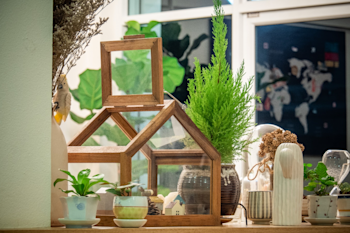Plants For Schools and Learning

In schools, creating an optimal learning environment is important in fostering students’ success and wellbeing. One often overlooked yet powerful element in this setting is the presence of plants. To many people’s surprises, plants play an important role in enhancing the overall quality of the learning experience. Whether in a school classroom or a home study area, understanding the selection and benefits of specific plants can transform standard learning environment into a thriving and supportive space for education.
Why Every School and Classroom Should Have Plants
Incorporating plants into education spaces can be a crucial tool in enhancing the quality of learning. Whether a school classroom, or a study space at home, selecting the right plants can contribute to enhancing learning amongst young people.
Plants provide so many benefits to a child’s mental and physical wellbeing. They have practical uses, health benefits, and they can even increase a child’s ability to learn. Learn more about for which plants to pick to create a positive learning environment at school or at home.
Health and wellbeing
Fostering health and wellbeing is crucial at schools, as it directly influences a student’s capacity to learn and concentrate. A healthy learning environment contributes to better cognitive function, reduced stress levels and overall emotional wellbeing. Choosing to include live plants into schools’ classrooms is a practical and natural way to enhance both health and wellbeing. Our list of plants for schools includes plants that do not only improve air quality but create a more inviting and focused atmosphere for students. See the list of some of the best plants for health and wellbeing:
Spider Plants: Excellent for purifying air, these plants are easy to maintain in low sunlight, making them a great choice for indoor learning spaces.
English Ivy: Known for its air-cleansing properties, English Ivy thrives in minimal sunlight, enhancing the air quality in classrooms.
Bamboo: Bamboo plants are great for filtering indoor air and are well-suited to indoor learning spaces, requiring little natural light.
These plants are not just beneficial for purifying air; they can also help in reducing dust and maintain cleaner surfaces. Well-watered plants also contribute to increased humidity levels, which can be helpful to students with respiratory diseases like asthma.
Learning and behaviour
As well as making it easier to breathe, houseplants reduce physiological and psychological stress which makes children feel comfortable and soothed — the perfect state to begin learning. Participating in plant care can be a tool for coping with back to school anxiety, or simply a way to enhance the space.
There has been plenty of research into this calming effect of plants in workplaces: offices are using plants for productivity, according to the University of Exeter and interaction with plants can increase short term memory, the University of Michigan has found. Indoor plants were even suggested to combat eye-strain and headaches for people who spend a lot of time around computers, as so many young learners do, by the Journal of Physiological Anthropology.
This research suggests that having houseplants in learning environments as well as workplaces could help kids focus and retain the information they’ve learnt during lessons, as well as decrease the effects of screen fatigue on younger generations.
Responsibility and empathy
Incorporating plants for schools into the classroom is an effective way to teach students about responsibility and empathy. This hands-on experience can teach children to understand the importance of caring for another living thing, fostering essential life skills. By being responsible for watering and nurturing their plants, students learn the value of regular care and attention. This routine mirrors the discipline and consistency required for effective study habits.
When students regularly tend to their plants, they are practicing a form of routine and commitment that is directly transferrable to their study patterns. Just as a plant thrives with consistent care, students can see that their knowledge and understanding grow with regular revision and study.
Best plants for productivity and concentration
When selecting plants for schools, it’s important to consider varieties that specifically enhance productivity and concentration. These plants not only add a touch of nature to the classroom, but also actively contribute to creating an environment for focused learning. Here’s the list of best plants known for boosting productivity and concentration:
Lemon Balm: Recognised for its ability to improve mood and cognitive function, lemon balm is a great plant for concentration.
Rosemary: Known for its aromatic properties that can improve memory and concentration, rosemary is an ideal plant for school, helping to stimulate student’s mental clarity.
Peppermint: With its unusual scent, peppermint is excellent for enhancing alertness and improving productivity and concentration, making it a great addition to any classroom.
Aloe Vera: Besides its air purifying qualities, aloe vera is known to enhance mental focus and makes a great choice for enhancing productivity.
Ginseng Ficus: Ginseng Ficus plant is said to be able to reduce stress and improve concentration, enhancing student’s learning by helping them maintain focus.
Projects and practicals for schoolchildren
Many of the plants for schools can be used as resources for biology lessons. Plants that are fast-growing, like beans, sprouts, and some garden vegetables, work perfectly as time and budget-friendly science projects because kids can see the results over the course of a few days without microscopes or other costly equipment.
Cress in particular is often used to show germination, as it happens very quickly and the seeds don’t have to be covered by soil to grow. <p>Plus, kids can use the cress they have cultivated in various recipes to encourage them to think about where their food comes from.
Growing cress seeds in different conditions is a good basic experiment for introducing children to variables. For example:
Give one pot water and sunlight
Give one pot water but no sunlight
Give one pot sunlight but no water
Give one pot no sunlight nor water
Ask them to make predictions about which seeds they think will grow best, then show them how to record their results. Afterwards, they can analyse what they have found and determine what the organism needs to survive. These are all key skills used in scientific research that can then be applied to bigger and more complex experiments in the future, so it’s good to teach them early on.
This great advice could really help your child revise in a positive learning environment! We’ve also got some alternative revision tips for extra ideas when preparing for exams on our blog.
Power of plants in learning environments
Now that you know just how powerful and important plants can be in any learning environment, from purifying air to enhancing focus and concentration, it’s clear that incorporating them into educational settings brings numerous benefits.
Explore Learning has many beneficial free resources and online tuition and face-to-face tutoring to support your child’s learning and help them achieve their full potential!
Cancel anytime
No joining fee
In centre or online
Memberships to suit you
Cancel anytime
No joining fee
In centre or online
Memberships to suit you
Cancel anytime
No joining fee
In centre or online
Memberships to suit you




